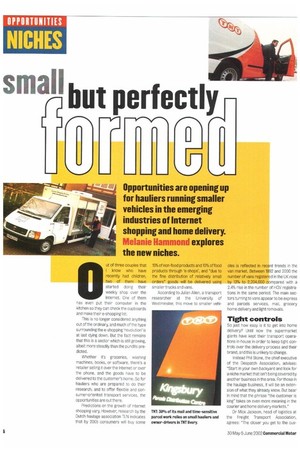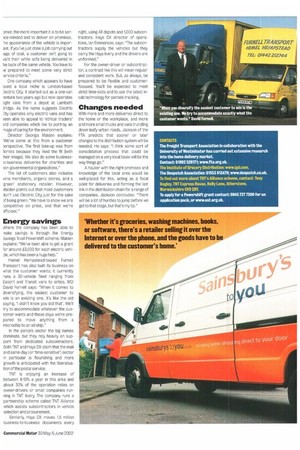small
Page 46

Page 47

If you've noticed an error in this article please click here to report it so we can fix it.
but perfectly 1
Opportunities are opening up for hauliers running smaller vehicles in the emerging industries of Internet shopping and home delivery. Melanie Hammond explores the new niches.
ut of three couples that I know who have recently had children, two of them have started doing their weekly shop over the Internet. One of them has even put their computer in the kitchen so they can check the cupboards and make their e-shopping list.
This is no longer considered anything out of the ordinary, and much of the hype surrounding the e-shopping 'revolution' is at last dying down. But the fact remains that this is a sector which is still growing, albeit more steadily than the pundits predicted.
Whether it's groceries, washing machines, books, or software, there's a retailer selling it over the Internet or over the phone, and the goods have to be delivered to the customer's home. So for hauliers who are prepared to do their research, and to offer flexible and consumer-oriented transport services, the opportunities are out there.
Predictions or the growth of Internet shopping vary. However, research by the Dutch haulage association TLN indicates that by 2005 consumers will buy some
15% of non-food products and 10% of food products through 'e-shops', and "due to the fine distribution of relatively small orders" goods will be delivered using smaller trucks and vans.
According to Julian Allen, a transport researcher at the University of Westminster, this move to smaller vehi
cies is reflected in recent trends in the van market. Between 1992 and 2000 the number of vans registered in the UK rose by 13% to 2,204,000 compared with a 2.4% rise in the number of HGV registrations in the same period. The main sectors turning to vans appear to be express and parcels services, mail, grocery home delivery and right removals.
Tight controls
So Just how easy is it to get into home delivery? Until now the supermarket giants have kept their transport operations in-house in order to keep tight controls over the delivery process and their brand, and this is unlikely to change.
Instead Phil Stone, the chief executive of the Despatch Association, advises: "Start in your own backyard and look for a niche market that isn't being covered by another business in the area. For those in the haulage business, it will be an extension of what they already know. But bear in mind that the phrase "the customer is king" takes on even more meaning in the courier and home delivery markets."
Dr Mick Jackson, head of logistics at the Freight Transport Association, agrees: "The closer you get to the cus nmer, the more important it is to be serice-minded and to deliver on promises. he appearance of the vehicle is imporant. If you've just done a job carrying out lags of coal, a customer isn't going to 'rant their white sofa being delivered in he back of the same vehicle. You have to re prepared to meet some very strict ervice criteria."
One company which appears to have ound a local niche is London-based ;lectric City. it started out as a one-var ,enture two years ago but now operates right vans from a depot at Lambeth 3ridge. As the name suggests Electric 31ty operates only electric vans and has men able to appeal to 'ethical traders' rid companies which like to portray an mage of caring for the environment.
Director Georgia Malden explains: We've come at this from a customer )erspective. The first take-up was from lorists because they liked the fit [with heir image]. We also do some business0-business deliveries for charities and ion-governmental organisations."
The list of customers also includes Nine merchants, organic stores, and a green' stationery retailer. However, vialden points out that most customers lon't use Electric City just for the sake pf being green: "We have to show we are competitive on price, and that we're 3fficient."
Energy savings
Pihere the company has been able to make savings is through the Energy Savings Trust Powershift scheme. Malden explains: 'We've been able to get a grart for around .£3,000 for each electric vehicle, which has been a huge help."
Hemel Hempstead-based Furnell Transport has also built its business on what the customer wants; it currently runs a 30-vehicle fleet ranging from Escort and Transit vans to artics. MD David Furnell says: "When it comes to diversifying, the easiest customer to win is an existing one. tt's like the old saying, 'I didn't know you did that'. We'll try to accommodate whatever the customer wants and these days we're prepared to move anything from a microchip to an airship."
In the parcels sector the big names dominate, but they rely heavily on support from dedicated subcontractors. Both TNT and Hays DX claim that the mail and same-day (or 'time-sensitive') sector in particular is flourishing and more growth is anticipated with the liberalisation of the postal service.
TNT is enjoying an increase of between 8-10% a year in this area and about 30% of the operation relies on owner-drivers or small companies running in TNT livery. The company runs a partnership scheme called TNT Alliance which assists subcontractors in vehicle selection and procurement.
Similarly, Hays DX moves 1.5 million business-to-business documents every night, using 48 depots and 1,000 subcontractors. Hays DX director of operations, Ian Emmerson, says: "The subcontractors supply the vehicles but they carry the Hays livery and the drivers are unformed."
For the owner-driver or subcontractor, a contract like this will mean regular and consistent work. But, as always, be prepared to be flexible and customerfocused. You'll be expected to meet strict time-slots and to use the latest incab technology for parcels tracking.
Changes needed
With more and more deliveries direct to the home or the workplace, and more and more small trucks and vans trundling down leafy urban roads, Jackson of the ETA predicts that sooner or later changes to the distribution system will be needed. He says: "I think some sort of consolidation process that could be managed on a very local basis will be the way things go."
A haulier with the right premises and knowledge of the local area would be well-placed for this, acting as a focal point for deliveries and forming the last link in the distribution chain for a range of companies. Jackson concludes: "There will be a lot of hurdles to jump before we get to that stage, but that's my tip."
























































































































































